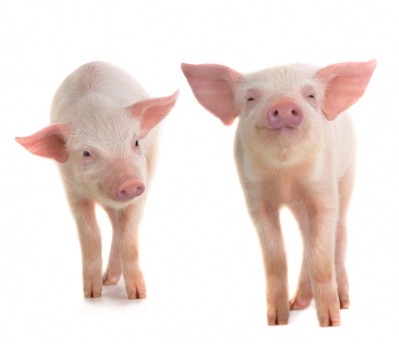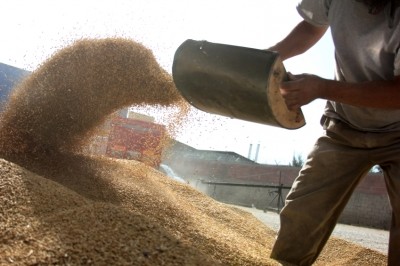Contaminated feed may be vector for PEDv transmission, finds a report from the CFIA

In a paper, published in the October edition of Transboundary and Emerging Diseases, they document bioassay tests they carried out on spray dried porcine plasma (SDPP) and feed supplemented with SDPP following a number of PED virus outbreaks on Ontario pig farms earlier this year.
“Although transport of pigs in inadequately cleaned trailers has been an implicated source of transmission of PEDv (Lowe et al, 2014), other modes of transmission may also exist. Our study indicates that PEDv contaminated SDPP may be one such mode for introducing the virus into a naïve pig herd,” said the authors of the report, led by Soren Alexandersen, executive director of the CFIA's National Centers for Animal Disease (NCAD) and for Foreign Animal Disease (NCFAD).
The paper details trials carried out in March this year, under controlled laboratory conditions, to determine whether a SDPP supplement or feed contained sufficient infectious PEDv to infect weaned piglets.
“While a typical PEDv sequence could be obtained directly from the SDPP samples used for inoculation, only one of the two selected feed samples produced a PCR amplicon in the conventional S gene RT-PCR assay that was of the correct size. The sequence of this product, although consistent with PEDv, was not of sufficient quality to make a definitive conclusion,” said the CFIA led team.
And even though the tested PEDv genome positive feed did not result in obvious piglet infection in the bioassay experiment, the authors stressed that contaminated feed cannot be ruled out as a likely source of PED viral infection in the field “where many other variables may play a contributing role.”
They also said that it is possible that the limited bioassay studies described in their report are likely “much less sensitive” than what might occur under field conditions.
“Many more piglets than used in this study coupled with larger amounts of feed, more stressful field conditions and ongoing infections may influence susceptibility of animals to PEDv contaminated feed,” they reported.
Details of the bioassay experiments
In late January 2014, the first case of PED was diagnosed in a swine herd in south-western Ontario. An epidemiological investigation of the Ontario PED cases pointed to feed as a common risk factor.
As a result, several lots of feed and spray-dried porcine plasma (SDPP) imported from the US and used as a feed supplement were tested for the presence of PEDv genetic material. Several of these tested positive, supporting the possibility that contaminated feed may have been responsible for the introduction of PEDV into Canada.
These findings led the CFIA researchers to conduct a bioassay experiment in which three PEDv positive SDPP samples (from a single lot) and two PEDv-positive feed samples supplemented with this SDPP were used to orally inoculate three-week-old piglets.
Although the feed-inoculated piglets did not show any significant excretion of PEDv, the SDPP-inoculated piglets shed PEDv at a relatively high level for over 9 days, they reported.
The authors concluded that this high level of PEDv excretion suggested the tested SDPP contained infectious PEDv.
“This was supported by S gene RT-PCR results and sequences and by seroconversion. Moreover, the infection spread to two of three contact piglets introduced at day seven. The 12 piglets in the SDPP group were inoculated with three samples from different pallets of the same lot number in groups of four piglets.
The kinetics of PCR positivity did not appear to differ among these piglets indicating that all three samples may likely have contained infectivity,” they added.
However, they said that as the piglets were kept together in the same room, they were unable to “unequivocally determine” that all samples were infective but “can state that at least one of the three samples contained infectivity and that the results indicate that all three may likely have done so.”
Traces of PEDv genetic material found in feed
While inoculation with the tested feed samples did not produce any significant excretion of PEDv, the researchers said genetic material could be detected in the feed at trace levels and a single inoculated piglet at day three had traces of PEDv genetic material in its rectal swab that was shown to be similar in sequence to the other samples tested.
They said the results from the analysis of the feed samples were, thus, inconclusive, and that it was not possible to determine whether it is infectious or not by bioassay.
Moreover, they said the feeds in question “only contained 6% SDPP and, furthermore, had been in use for several weeks in the field prior to their evaluation in our bioassay experiments which, although stored under warehouse conditions, may have resulted in a further loss of any potential minimal infectivity present initially.”
Source: Transboundary and Emerging Diseases, Volume 61, Issue 5, pages 397–410, October 2014
Published online ahead of print: DOI: 10.1111/tbed.12269
Title: Investigation into the Role of Potentially Contaminated Feed as a Source of the First-Detected Outbreaks of Porcine Epidemic Diarrhea in Canada
Authors: S. Alexandersen et al








